Today in Kantolomba, we arrived early enough to see the children before their meal. As we got out of the car, we were greeted with a resounding “Good Morning, Madam!”

The children greeting us.
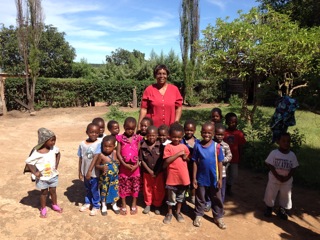
Georgina and her morning class.

Peter, one of the carpenters, and his beautiful son, Joseph. What a lovely pair of smiles!
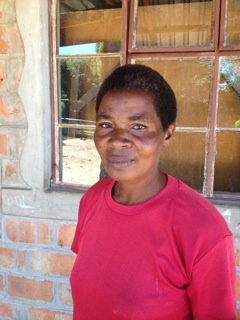
Ethel, who teaches the youngest children in the morning.
The kids were starting play-time, and we joined them in several activities. We started with the “What’s your name?” song. They knew the song from the Genki program, and over 30 of them sang it with us. As children were picked to say their name, those who hadn’t been picked would wiggle their way up front to be chosen. One little boy really wanted to be next and made sure the finger was pointed at him! How wonderful to see them all participating together.
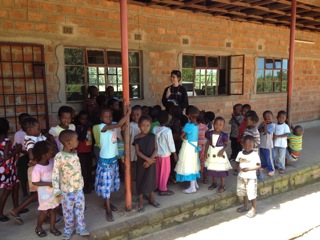
The children gather around to sing “What’s Your Name?”
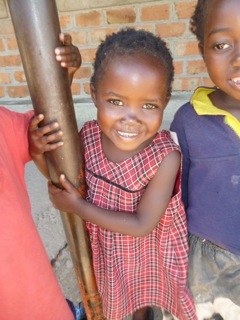
A big smile for the camera.

Older Foster, one of the cooks for the day.
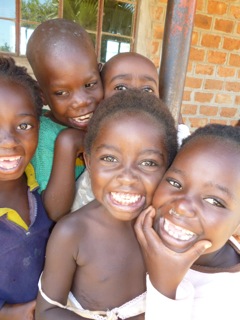
A group of smiles!
Then it was on to a game similar to the American style duck-duck goose. Sung in Bemba, the children used a soccer ball to select the next student. One of the students picked Jen to the delight of the whole group. After that game was over, it was on to lunchtime for the children. On today’s menu – nshima, beans and pumpkin leaves. The team shared with us a story about nshima. Apparently, if you go to someone’s house and they feed you a meal of rice, beans, and all sorts of other things, but no nshima, if a friend asks if you ate today, you will say “No, I had nothing.” Nshima must be on the menu!
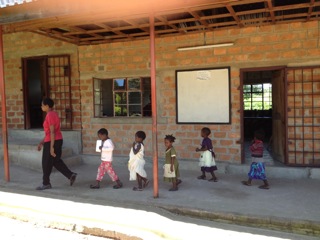
Ethel taking her students to eat. Is that cute, or what?!

The women preparing peanut butter for the next day. They grind the peanuts and add salt along the way.
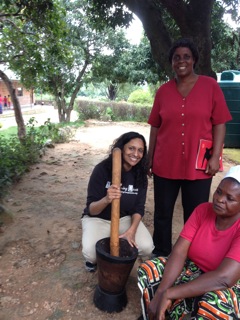
Georgina made sure Sreedevi ground some peanuts, too!
This next video is simple enough.
But, we’re certain that for you avid blog readers, and certainly any of you who have been to Kantolomba with us, it is sheer delight. Imagine—Jen is just standing in a classroom, waiting for the grown-ups to gather for the next meeting, and in walks a handful of students who have just finished lunch. Turns out they are the students who started in Joy’s immersion English room 18 months ago and are now in grade one. They march in, go right up to the chart of fruits, and begin telling Jen what each one is!!! Perhaps the most remarkable difference we see in the students who have been in the English immersion from the start in relation to the ones just starting out is their level of confidence. They are around 6 years old and will interact with any of us and hold a conversation. There just are not words to tell you how thrilling it is!
Soon the adults reconvened to continue the conversation about the Living English program. Today, we started with asking each of the teachers to speak to whether they wish to take an active role in this next phase of the English learning at Living Compassion.
Each teacher spoke eloquently to why she felt the idea of bringing English to life, making it more tangible, three-dimensional for the students is essential. Georgina shared an experience of seeing a newscast with her daughter, Mirriam. Local children had been selected to help read the news. Mirriam was very excited seeing this, and asked Georgina how people became journalists. Georgina told her it was by studying hard to pass through grade 12 then going on to journalism school in Lusaka.
And the one that moved us most was Joy’s account of the children having come to the airport as our arrival surprise when we were here in August. She said that after that trip they all came home and told all their friends about it and talked about it for weeks. One found a picture of an airplane and brought it to Joy to tell her (in English!) all about the airplane. Joy then used that picture to build a whole lesson around it. Happy dances all around!
Excellent, so we are all on board. Next we tackled the issue of how many students to start with and who should they be? This brought forth a very robust discussion. As you may recall, we left off yesterday’s meeting in agreement that we want all 800 children to know about the possibility that is available to them. But, how to manage taking 800 children on field trips?!
The conversation was quite rich. We remarked to ourselves that even this is a big difference from a few years ago, when it was difficult to get folks to fully participate and give their honest opinions about things. No more! It was a lively debate with many excellent points articulated.
Just when it seemed we may be at an impasse—truly, how were we going to make the program be effective, not exclude anyone, and really motivate those who most want to learn—it dropped in: the analogy of a chick in its shell. When a chick is in its shell ready to come out, it starts pecking. The mama chicken then pecks on the outer shell to help the chick come out. How about we begin by focusing on the children who are pecking on their shells?
Currently, there are 55 children from Grades 1-7 in government school who choose to come to extra lessons at the site. These children are pecking! It seemed so obvious once we said it, but things like that always are. Once you see it, it is clear. The most brilliant part is that we plan to have an “open enrollment” period some number of times each year (not sure how often yet). What this means is that the students who have already stepped forward to demonstrate their commitment to learning will be the ones who are “rewarded” by being included in this new, exciting program. These students will then become English ambassadors. They will return from the trips with great stories and inspire the next group of students who want to be included. Those children can join in the open enrollment period. In this way, instead of convincing students to participate in the educational activities, it will spread organically, and only those who are ready, self-selecting, will be involved. Classes will be filled with children who want to be there, not “should.”
After a short break, we came back to begin to hash out some of the detail. So, there are 55 children currently opting in to the extra lessons, but within those there are varied levels of commitment. Do all 55 get to participate in the trips regardless of attendance to the classes? After some general brainstorming, we decided to hold that conversation for the next day and move into something a bit more creative— deciding on what types of trips the children could go on! The team came up with over 20 sites, from medical clinics to the library to the airport to countless local businesses.
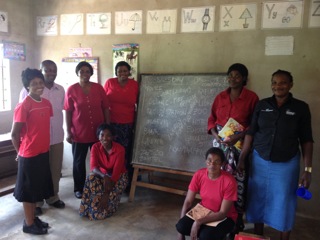
The team standing next to the chalkboard, full of possible trips!
It was time to break up the sitting and talking for a bit so we took the opportunity to explore how technology could support both the teachers and students in English learning. We brought an iPad with us with apps geared towards English learning. We showed the team how the iPad worked, using an app for the Dr. Seuss book, The Cat in the Hat! The student can read each page of the book on their own by pressing the words. When you press a word with your finger, like “fish,” the app says “fish” out loud. You can also press the pictures to hear the word read and see it written. It’s a brilliant learning-to-read experience.
The team enjoyed interacting with the app. Quickly the favorite thing to do was to turn the page, using your finger in a “swoosh” motion across the iPad. When the next person would get the iPad to try out, the others would say “Turn the page!”
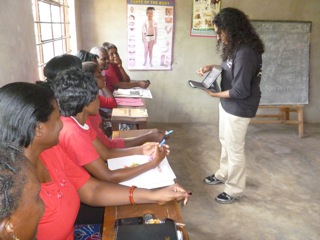
Demonstrating how the iPad works.

The team enjoying the demonstration.

Charles, who teachers the older children, turns the page!
It was then lunchtime for us grownups—whew! After lunch, we decided to see how children might respond to the iPad. So we sat down and started playing with a program, and quickly the children came over to look and within one minute were playing with it.
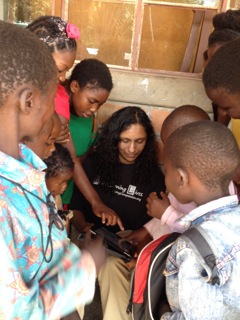
The children leaning in to see what is going on and how they can participate.
We then left to go to Masala market to pick up some more chitenge for pantalombas, where we also scored a beautiful avocado for a future dinner. The avocado was quite large, and cost 3 kwacha – approximately 51 cents. In California, an avocado that size would easily cost $3 or $4!
Our last stop was to meet with a tailor to get an estimate on how much it would cost to make the pants. After some skillful negotiating (we’re quite Zambian at this point), a price for a sample was agreed upon. It had been a full day, so we headed back to Castle Lodge to rest up for tomorrow.
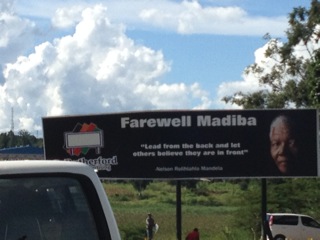
A wonderful tribute to Nelson Mandela. We see this on our way back to the lodge every day. Theresa tells us that after his death he was celebrated here just as if he had been President of Zambia. We remarked that the Nelson Mandelas of the world do not come along often and are a gift far beyond their own country of origin—they seem to have lived for all humanity, or, we could say, for all Life. Yes, farewell, Madiba, and our deepest gratitude.
